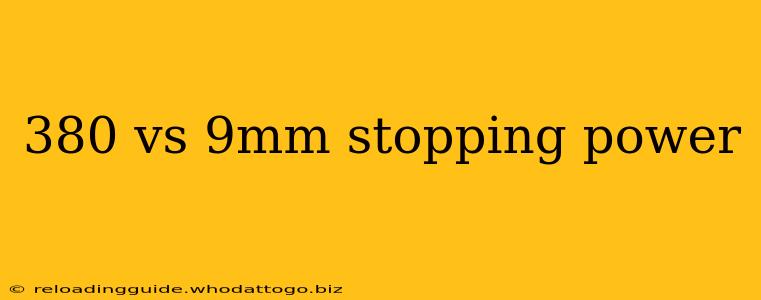The age-old debate: .380 ACP versus 9mm—which round reigns supreme in stopping power? This isn't a simple question with a simple answer. Stopping power is a complex issue influenced by factors beyond just caliber, including bullet design, projectile weight, velocity, and even the placement of the shot. This detailed comparison will delve into the nuances of each cartridge, helping you understand the strengths and weaknesses of both.
Understanding "Stopping Power"
Before we compare, let's define our terms. "Stopping power" isn't a scientifically precise measurement. It generally refers to a cartridge's ability to incapacitate a target quickly and reliably. This involves a combination of factors:
- Energy Transfer: How much energy the bullet transfers to the target upon impact. Higher energy generally leads to greater tissue damage and a higher likelihood of incapacitation.
- Wound Cavity: The size and shape of the wound channel created by the bullet's passage through the body. A larger, more disruptive cavity can cause more immediate incapacitation.
- Bullet Expansion: The ability of a bullet to expand upon impact, increasing its diameter and thus increasing tissue damage. Hollow-point bullets are designed specifically for expansion.
- Shot Placement: This is arguably the most crucial factor. A well-placed shot to a vital organ, regardless of caliber, will have a far greater effect than multiple poorly placed shots.
.380 ACP: A Closer Look
The .380 ACP (Automatic Colt Pistol) is a relatively small and low-powered cartridge. Its smaller size often translates to greater magazine capacity in smaller firearms, making it popular for concealed carry. However, its lower energy transfer compared to the 9mm is a significant consideration. While modern .380 ACP ammunition utilizes hollow-point designs to maximize expansion and wound cavity creation, its inherently lower energy limits its potential for immediate incapacitation compared to the 9mm.
Advantages of .380 ACP:
- Smaller Size and Weight: Ideal for concealed carry and easier to handle for individuals with smaller hands.
- Greater Magazine Capacity (in smaller firearms): Allows for more rounds in a smaller package.
- Lower Recoil: Easier to manage for novice shooters.
Disadvantages of .380 ACP:
- Lower Energy Transfer: Generally less effective in stopping power compared to the 9mm.
- Limited Penetration: May not penetrate sufficiently through barriers or clothing.
- Greater reliance on perfect shot placement: Given the lower energy, precise shot placement is even more critical for effectiveness.
9mm: A Powerful Contender
The 9mm Parabellum (also known as 9x19mm Luger) is a vastly more powerful cartridge than the .380 ACP. Its higher velocity and energy transfer result in a significantly greater potential for incapacitation. Furthermore, a wide variety of 9mm ammunition is available, offering different bullet weights, designs (including hollow-point, full metal jacket, and others), and expansion characteristics, allowing for tailored selection based on specific needs and circumstances.
Advantages of 9mm:
- Higher Energy Transfer: Significantly greater stopping power potential compared to the .380 ACP.
- Greater Penetration: Better ability to penetrate barriers and clothing.
- Wider Ammunition Selection: Allows for choosing ammunition optimized for specific situations.
Disadvantages of 9mm:
- Higher Recoil: Can be more challenging for novice shooters to manage.
- Larger Size and Weight: May be less comfortable for concealed carry in smaller firearms.
- Generally lower magazine capacity (in smaller firearms): Though larger capacity magazines exist, this is often lower than .380 ACP in comparable firearm sizes.
The Verdict: No Clear Winner
Ultimately, declaring a definitive "winner" between .380 ACP and 9mm in terms of stopping power is misleading. The effectiveness of each cartridge is highly dependent on numerous variables. The 9mm generally boasts superior stopping power due to its higher energy transfer and better penetration, but the .380 ACP remains a viable option for self-defense, particularly for individuals who prioritize concealability and manageability. Shot placement remains the single most crucial determinant of success in any self-defense scenario, regardless of the caliber used. Proper training and practice are essential for maximizing the effectiveness of any firearm.

